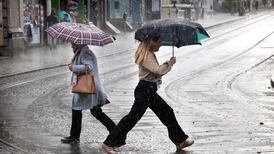
"Time is a nightmare that madmen have always felt themselves at home in." The science fiction writer Theodore Sturgeon is quoted by John Wray in The Lost Time Accidents. It's a massive multi-generational novel that follows the fortunes of the Tolliver family through the 20th century, taking in Einstein's theory of relativity; turn of the century Viennese salons and the Wittgenstein family; anti-semitism and the Holocaust; and the atom bomb and 1950s science fiction.
This narrative of physics, metaphysics and madness is delivered in the form of an extended letter by Waldemar “Waldy” Tolliver to his lover Mrs Haven. Like a “cicada in a glass”, Waldy is trapped in a zone outside the “chronostream” of linear time. From there he tells us of his great-grandfather, Ottokar Toula’s formulation of a theory of circular time, or Time Accidents. He is about to reveal it to the world in 1903, when he is killed in a traffic accident.
His sons, Waldemar and Kaspar follow in his footsteps, Kaspar becoming a physicist who emigrates to the US, whilst Waldemar morphs into a Mengele-like Nazi who uses Jewish concentration camp inmates as subjects for experiments into time travel.
Then there's Waldy's father Orson Scott Tolliver, a pulp science fiction writer who is an obvious amalgam of L Ron Hubbard and Orson Scott Card. The cult status of his novel The Excuse echoes that of Robert Heinlein's Stranger in a Strange Land. Its time travel conceits are seized upon by the sinister Mr Haven to found the United Church of Synchronology, whose adherents call themselves "Iterants" and declare "consciousness is a time machine".
<em>The Lost Time Accidents</em> has the paranoid intensity of Philip K Dick's work, but Wray's undoubted imagination suffers from the clutter of competing threads
Like Scientologists, they are duped into handing money hand over fist to attain the “Seventeenth Level of Iteration”. Orson eventually takes on Hugh Hefner aspects, “surrounded by a swarm of bee-hived, pastel-skirted zombies” and a sexual companion he believes to be an android.
Numerous writers
Wray pays homage to and parodies numerous writers of science fiction and fantastic literature. There's Philip K Dick's Time out of Joint ("the time, at least for Orson, was severely out of joint"). There are allusions and references to 2001: A Space Odyssey, The Invasion of the Body Snatchers and C S Lewis'sThe Magician's Nephew. In his time bubble, Waldy starts to crawl on all fours like a cockroach, a nod to Kafka's Metamorphosis.
Wray's notion of a multiplicity of time streams running parallel to our own is not dissimilar to Michael Moorcock's Multiverse – and his ironic exploration of the 20th century's horrors has hints of Moorcock's Byzantium Endures.
Wray imagines the "Escher-like circularity" of time as a Möbius strip – and we find the novel dove-tailing back on itself like Samuel Delaney's Dhalghren.
Lyrical at his best
The Lost Time Accidents is a Grail Quest tale. The "lost time accidents" are "a jewel-encrusted chalice tucked away inside some sleeping monster's bowels". There is much beautiful writing. Wray is at his best when lyrical, not ironic, while there are epiphanic moments such as Orson's discovery of New York as "some private and melancholy city" .
Orson's sisters Enzian and Gentian inhabit an apartment cluttered with newspapers and bric-a-brac, attempting to build a time machine, also trying to freeze time in material objects – "like crustaceans depend for survival upon an outer skeleton, upon a shell of historic houses and apartments filled with things belonging to definable portions of the past". They are modelled on the same real-life subjects as E L Doctorow's Homer and Langley, and Wray also includes an imagined essay by Joan Didion about the sisters.
In The Lost Time Accidents the reader too often becomes a postmodern literary trainspotter. The novel is burdened by over-writing. A character can't simply drive a car – there will be a page describing his driving style. The Lost Time Accidents has the paranoid intensity of Philip K Dick's work, but Wray's undoubted imagination suffers from the clutter of competing threads: a dysfunctional family saga; a mediation on time and philosophy that discusses everybody from St Augustine to Nietzsche; and a science fictional ripping yarn. With judicious editing, it might have been a more involving novel. It should have taken its cue from Sturgeon, Dick and Moorcock, whose best work is marked by energy and brevity.
Liam Carson is the director of the IMRAM Irish Language Literature Festival, and author of Call Mother a Lonely Field











